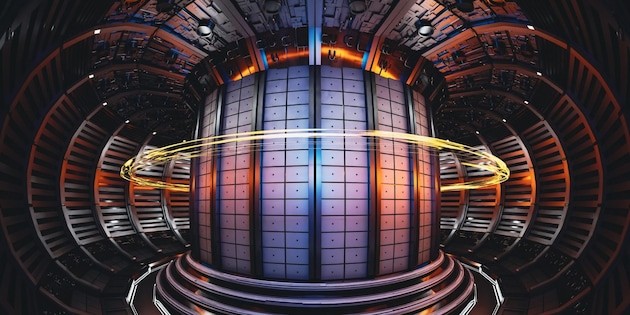Researchers have been working for decades to develop nuclear fusion as a safe alternative to nuclear fission. It is hoped that it could exploit the power of the sun and thus revolutionize energy production. This would make coal, gas and other fossil fuels obsolete – and the area currently needed for solar and wind power could also be significantly reduced. However, the technology is still in its infancy.
The tokamak is one of the most common fusion reactors. It features a toroidal design and uses strong magnetic fields to confine hot plasma in a vacuum and heat it to extremely high temperatures. The goal of such reactors is to recreate the conditions that occur in stars.
Nuclear fusion promises an almost inexhaustible source of energy because: It is based on hydrogen isotopes such as deuterium and tritium, which can be obtained from seawater. Tokamaks are central to the international research project International Thermonuclear Experimental Reactor (ITER). Like many similar projects, it aims to demonstrate the technical and economic feasibility of fusion energy as a clean and sustainable energy source.
The French Alternative Energies and Atomic Energy Commission (CEA) operates one such reactor, the Wolfram Environment in Steady-state Tokamak (WEST). Over a period of six minutes, researchers from the U.S. Department of Energy (DOE) and the Princeton Plasma Physics Laboratory (PPPL) now aim to achieve a plasma temperature of 50 million degrees Celsius (°C) – with an energy input of 1.15 gigajoules. This corresponds to 15 percent more energy and twice the density compared to the previous record.
“We need a new energy source that should be available continuously and permanently,” explained Xavier Litaudon, CEA scientist and chairman of the Coordination on International Challenges on Long duration Operation (CICLOP). Litaudon said PPPL’s work at WEST is an excellent example. “These are wonderful results. We have achieved a steady state regime, although we are in a difficult environment due to the tungsten wall.” The CICLOP is part of the International Atomic Energy Agency (IAEA).
Researchers at PPPL, which has been cooperating with WEST for some time, used a novel approach to measure various properties of plasma radiation. They used an X-ray machine from the Swiss manufacturer DECTRIS that was specially modified for this purpose.
The responsible X-ray group developed these instruments for tokomaks and other stellarators around the world, emphasized Luis Delgado-Aparicio. He is the head of PPPL’s advanced projects department and chief scientist of the X-ray detector project.
Numerous projects around the world are dealing with nuclear fusion. Some of the concepts used today were already described by Dänner and Knobloch in their work published in 1971 for the Max Planck Institute for Plasma Physics. They pursue different approaches, but are heading towards the same goal: a sustainable and, above all, secure power supply. Specifically, researchers use six main types of fusion reactors:
Research teams are continuously developing all of these projects. The “WEST” is just the next level of the original Tore Supra. At that time, the interior of the reactor was made of graphite tiles and used carbon instead of the tungsten used today.
“The tungsten wall environment is much more demanding than using carbon,” says Delgado-Aparicio. “It’s simply the difference between trying to catch the kitten at home and trying to pet the wildest lion.” However, tungsten has the advantage that it retains much less fuel – a property that is not particularly true for large reactors was acceptable.
While the new record break of six minutes is still a long way from allowing a tokamak to operate continuously, it is an important step. Because with every new record, the researchers come closer to their larger goal. If the reactor passes one threshold, the next one is not far away, and the same applies to the next one. If they can sustain nuclear fusion for 24 hours, it could become the energy source of the future.
Sources: own research; Princeton Plasma Physics Laboratory; “Possible types of fusion reactors, reactor physics and technical problems in its development” (MPG.PuRe, 1971)
By Philipp Rall
Many people are still annoyed about rising food prices. But now discounters and supermarkets are slashing prices for many popular foods. Experts are assessing how this will affect weekly shopping and whether this will mark the end of inflation.
Anyone who pays a lot in cash is exposed to a certain health and hygiene risk. The Sparkasse points this out and urges caution. Because the means of payment in any form is always a haven for numerous bacteria and germs
The original for this article “With the “Tokamak”, energy production with coal and gas could soon be history” comes from futurezone.de.









